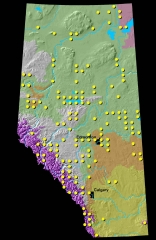Twinflower
Linnaea borealis – Linnaea is named after Carolus Linnaeus 1707-78), the ‘father of botany’, who established the classfication system of plants and animals which assigns each organism a two word name (genus and species). Borealis is named for the Greek god of the north wind, Boreas, which means ‘northern’.
Other names
- in Latin: Linnaea borealis L.
- in English: deer vine, ground vine, twin sisters
- in French: linnée boréale
Taxonomy
Honeysuckle Family (Caprifoliaceae)
Description
A low, creeping wildflower, standing only 5 cm to 10 cm tall, with a semi-woody stem. Stems creep along the forest floor and can grow to as long as 1m, forming loose mats.
- Leaves: Leaves are egg-shaped, 1 cm to 1.5 cm across, and usually have a few rounded teeth on the tip. Leaves do not occur on the flower stems. After the flowers and fruits have faded, the evergreen leaves remain on the plant, often hidden under the winter snow.
- Flowers: Flowers are small (6 mm to 15 mm long), pinkish white, bell-shaped, and are fragrant, especially towards evening. Flowers occur in pairs on V-shaped stalks.
- Fruit: Egg-shaped nutlets are 1.5 mm to 3 mm long, with hooked bristles.
Distribution
Widespread throughout Alberta.
Habitat
Occurs in rich, moist woods, coniferous or mixed, in open or semi-shaded areas. It can be found at a variety of elevations, up to treeline
How to Observe
- If the plants are very abundant, mark a plot about one metre by one metre in size.
- Record these dates:
- First bloom: When the first flowers are open in the patch observed.
- Mid bloom: When approximately half (50%) of the flowers on the plants under observation are open.
When does this plant bloom?
Flowers June to July.
Life Cycle
Once bloom is passed, small ‘nutlets’ develop. The hooked bristles on these twinflower nutlets catch on to fur, feathers or clothing of passer-by, who then carry them to new locations. Twinflower also spreads and forms colonies by sending out their long, rooting stems that send up shoots along their length.
Ecology
This is the only species in its genus. It tends to be found in areas of cold air drainage.
Phenology
Flowers June to July.
Human Uses
Some First Nations People made a tea from twinflower leaves. Native groups in eastern North America used twinflower to treat women who were pregnant, people with inflamed limbs or those with colds or suffering from insomnia, and children suffering from cramps, fever, or crying.
This was the favorite plant of Carolus Linnaeus, one of the ‘fathers of phenology”. In his Philosophia Botanica (1975), he proposed a phenology survey to ‘show how areas differ.’
Horticulture (Use in the Garden)
Twinflower is easy to propagate and makes an excellent native ground cover. It spreads rapidly, but not aggressively, in partially shaded spots.
Quotes
“He saw beneath dim aisles, in odorous beds
The slight Linnaea hang its twin-born heads
And blessed the monument of the man of flowers
Which breathes his sweet fame through the northern bowers”
-Emerson
References
Beaubien, E. 1991. Phenology of Vascular Plant Flowering in Edmonton and Across Alberta. Thesis, MSc. University of Alberta. Edmonton, Alberta.
Brown, A. 1970. Old Man’s Garden. 2nd edition. Evergreen Press Ltd. Sydney, British Columbia.
Erichson-Brown, C. 1979. Use of Plants for the Past 500 Years. Breezy Creeks Press. Aurora, Ontario.
Johnson, D., et. Al. 1995. Plants of the Western Boreal Forest and Aspen Parkland. Lone Pine Publishing. Edmonton, Alberta.
Kershaw, L., A. MacKinnon, and J. Pojar. 1998. Plants of the Rocky Mountains. Lone Pine Publishing. Edmonton, Alberta.
Marie-Victorin, F. 1991. Flore Laurentienne 3rd ed. Les Presses de l’Université de Montréal. Montréal, Quebec.
Moss, E. H. 1983. Flora of Alberta. 2nd edition. University of Toronto Press. Toronto, Ontario.
Wilkinson, K. 1999. Wildflowers of Alberta: A Guide to Common Wildflowers and Other Herbaceous Plants. University of Alberta Press and Lone Pine Publishing. Edmonton, Alberta.




